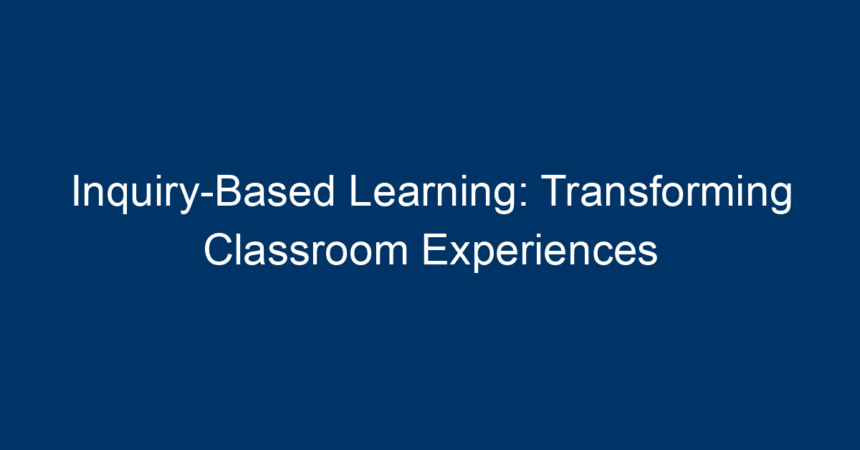In the ever-evolving landscape of education, traditional teaching methods are being challenged, leading to innovative pedagogical approaches that engage students more deeply and meaningfully. One such transformative approach is inquiry-based learning. This method shifts the focus from rote memorization to an active exploration of concepts, encouraging curiosity and critical thinking. In this article, we will delve into the principles of inquiry-based learning, its benefits, challenges, and practical ways to implement it in the classroom.
What is Inquiry-Based Learning?
Inquiry-based learning (IBL) is an educational approach that emphasizes student-driven exploration and problem-solving. Instead of simply presenting information, educators create a learning environment where students formulate questions, conduct research, and draw conclusions based on evidence. This active engagement fosters a deeper understanding of the subject matter, allowing learners to retain information more effectively.
The Core Principles of Inquiry-Based Learning
-
Student-Centered Focus: At the heart of inquiry-based learning is the student. Education shifts from a teacher-led model to one where learners take an active role in their education. This empowers students and fosters independence.
-
Questioning and Curiosity: Inquiry-based learning starts with questions. Educators encourage students to articulate their interests and curiosities, creating a foundation for discovery and investigation.
-
Research and Exploration: Students engage in hands-on research, utilizing various resources, including books, academic journals, and online databases. This exploration helps them learn how to seek out and evaluate information critically.
-
Collaborative Learning: IBL often involves group work, where students collaborate to share ideas and findings. This teamwork helps develop communication skills and fosters a sense of community.
- Reflection and Assessment: Reflective practices are crucial in inquiry-based learning. Students assess their progress, think critically about their findings, and adjust their approaches as necessary.
Benefits of Inquiry-Based Learning
1. Enhanced Critical Thinking Skills
Inquiry-based learning encourages students to analyze, synthesize, and evaluate information rather than passively consuming it. By addressing complex questions and problems, learners develop stronger critical thinking skills, which are essential for success in higher education and the workforce.
2. Increased Engagement and Motivation
When students pursue questions and topics that interest them, their intrinsic motivation skyrockets. The hands-on, exploratory nature of IBL keeps students engaged and invested in their learning journey.
3. Improved Retention of Information
Research shows that students who engage in inquiry-based learning remember material longer and can apply their knowledge in different contexts. This deep comprehension results from the active involvement in the learning process.
4. Development of Lifelong Learning Skills
Inquiry-based learning fosters a love for learning. By encouraging curiosity and exploration, students develop skills and attitudes that promote lifelong learning and adaptability in an ever-changing world.
5. Promotion of Collaborative Skills
Working in groups enhances social skills and teaches students how to navigate differing opinions and ideas. This collaborative environment mirrors real-world experiences, preparing students for future teamwork in professional settings.
Challenges of Implementing Inquiry-Based Learning
While inquiry-based learning can be highly effective, it is not without its challenges. Educators must be prepared to navigate common obstacles:
1. Teacher Preparedness
For successful implementation of inquiry-based learning, educators need proper training. Many teachers may feel unprepared or uncertain about facilitating student-led inquiries, which can hinder the process.
2. Curriculum Constraints
Traditional curricula often emphasize standardized testing and fixed content. This can limit the flexibility needed for inquiry-based learning, making it difficult for teachers to implement an exploratory approach.
3. Time Consumption
Inquiry-based projects can be time-consuming, requiring lengthy commitment from both teachers and students. Educators may struggle to balance these projects with the prescribed curriculum timelines.
4. Assessment Difficulties
Traditional assessment methods may not effectively capture the depth of learning that occurs in inquiry-based settings. Educators must explore alternative assessment strategies to evaluate student progress meaningfully.
Steps to Implement Inquiry-Based Learning in the Classroom
Implementing inquiry-based learning may seem daunting, but by following a few structured steps, educators can create vibrant, engaging learning environments.
Step 1: Foster a Curious Environment
Create a classroom atmosphere that encourages questions. Display thought-provoking quotes or images, and initiate discussions that prompt students to think critically and engage their curiosity.
Step 2: Introduce Open-Ended Questions
Begin lessons with open-ended questions that cannot be easily answered with a simple "yes" or "no." These questions should require students to explore, investigate, and contemplate multiple perspectives.
Step 3: Develop Research Skills
Teach students how to access various resources, including books, databases, and reliable online sources. Show them how to evaluate the credibility of information, which is crucial in an age of misinformation.
Step 4: Encourage Collaboration
Design group projects that encourage collaboration and teamwork. Create roles within the group to ensure all students contribute and learn from one another, fostering a sense of shared responsibility.
Step 5: Allow for Reflection
Integrate reflective practices into your lessons. Encourage students to think about what they learned, what went well, and what they would do differently in future inquiries. Reflection enhances the depth of learning.
Step 6: Assess Holistically
Explore performance-based assessments that align with inquiry-based learning. These could include presentations, portfolios, or self-assessments, which enable students to demonstrate their understanding in diverse ways.
Conclusion: The Future of Learning
Inquiry-based learning is not just a teaching method; it’s a transformation in the educational experience. By placing students at the center of their own learning through exploration, questioning, and collaboration, we cultivate critical thinkers who are prepared for the complexities of the modern world.
Actionable Insights
- Start Small: Introduce a single inquiry-based project to your curriculum and assess its impact.
- Collaboration is Key: Partner with other educators to share ideas and resources for implementing inquiry-based learning.
- Seek Professional Development: Attend workshops or training sessions to enhance your skills in facilitating inquiry-based methods.
- Share Success Stories: Document and share positive outcomes with colleagues and educational communities to inspire further adoption of IBL.
Inquiry-based learning paves the way for a richer, more engaged classroom experience. As we embrace this dynamic method, let us empower our students to navigate the world with curiosity, confidence, and critical thinking skills that will serve them long into the future.




